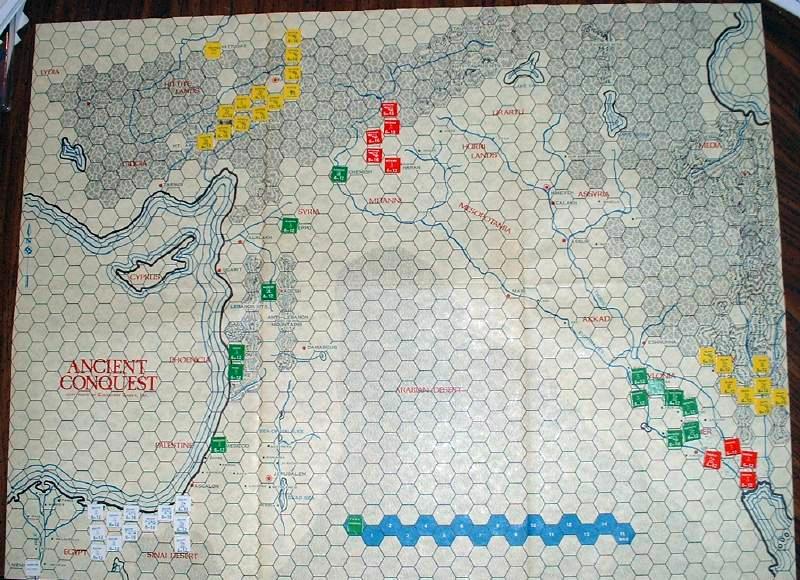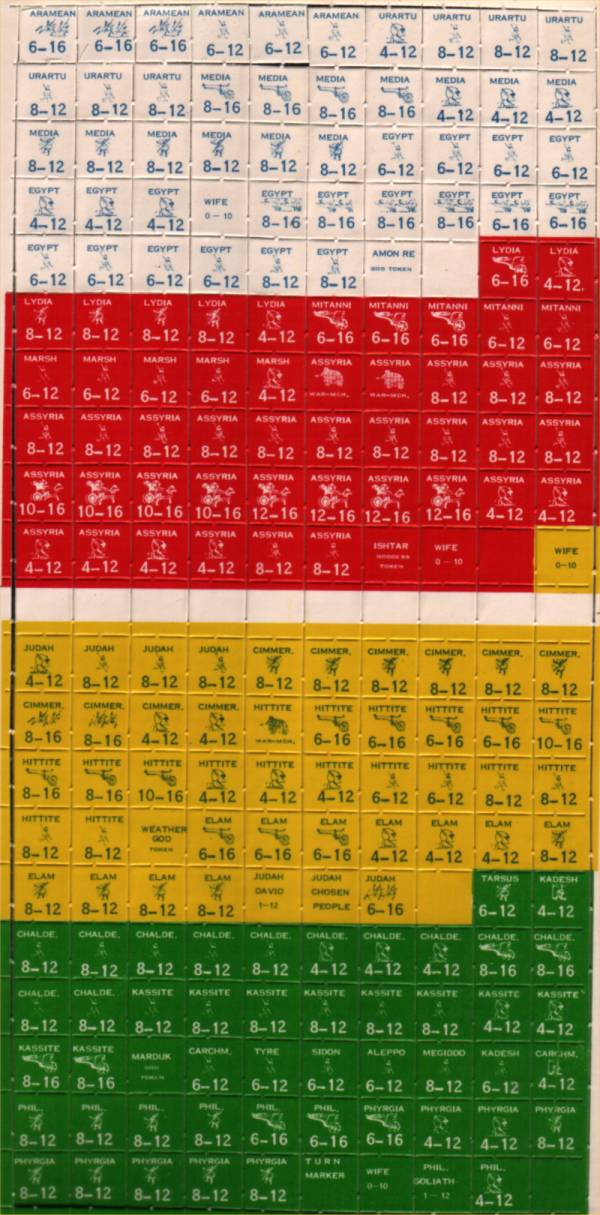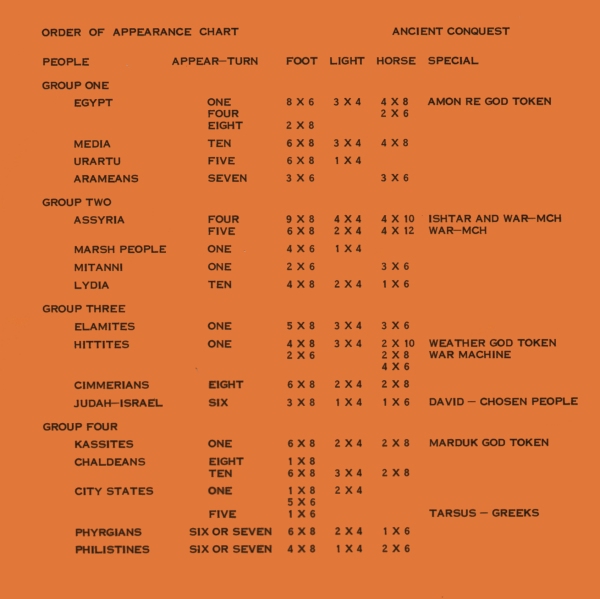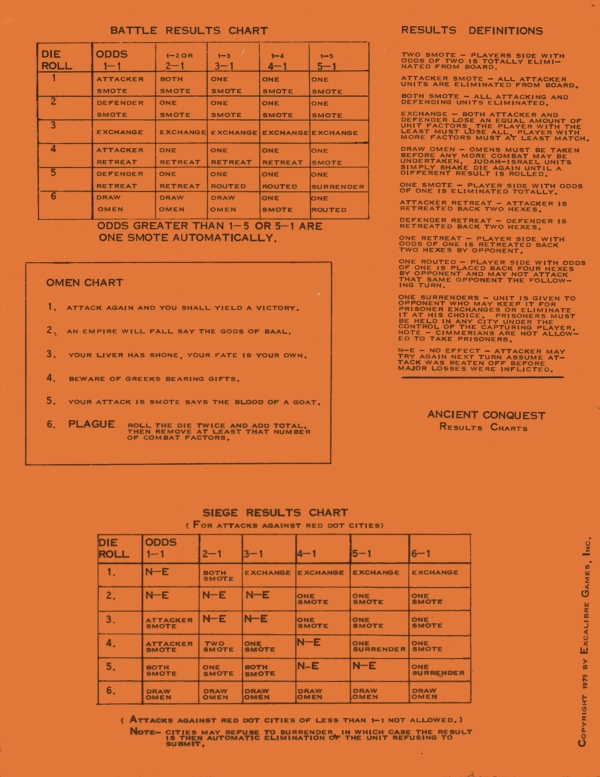At the Dawn of History (and Wargaming)
Ancient Conquest, Excalibre Games, 1975. Designer: Dennis P. O'Leary
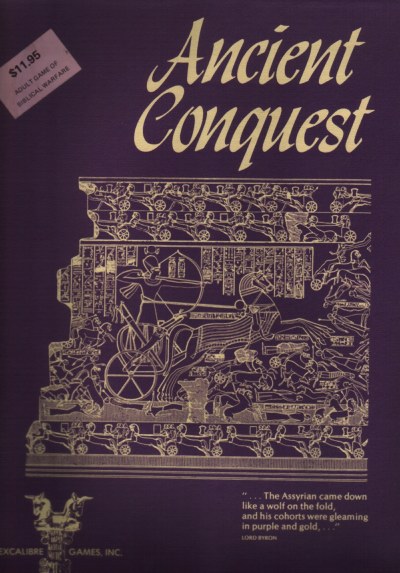 Excalibre Games was one of the earliest and least admired “Third World” wargame companies. With one exception, every game that it produced received generally unfavorable notices. That exception proved, however, that any rough can throw up a diamond. Ancient Conquest was the first grand historical wargame, portraying the succession of peoples in the Fertile Crescent from the heyday of the Egyptian New Kingdom through the overthrow of Assyria by the Chaldeans and Medes. Its concept was borrowed by later, better known titles, most notably Avalon Hill’s Britannia and Maharaja and Clash of Arms’ recent return to the Ancient Near East in Chariot Lords. (Other exemplars of the genre are Hispania (Azure Wish), Rus’ (Simulations Workshop) and Peninsula Italica (Camelot Games).)
Excalibre Games was one of the earliest and least admired “Third World” wargame companies. With one exception, every game that it produced received generally unfavorable notices. That exception proved, however, that any rough can throw up a diamond. Ancient Conquest was the first grand historical wargame, portraying the succession of peoples in the Fertile Crescent from the heyday of the Egyptian New Kingdom through the overthrow of Assyria by the Chaldeans and Medes. Its concept was borrowed by later, better known titles, most notably Avalon Hill’s Britannia and Maharaja and Clash of Arms’ recent return to the Ancient Near East in Chariot Lords. (Other exemplars of the genre are Hispania (Azure Wish), Rus’ (Simulations Workshop) and Peninsula Italica (Camelot Games).)
The game is designed for four players, each of whom guides the destinies of four or five peoples. The White player, for example, commands, in order of appearance, Egypt, Urartu, the Aramaeans and the Medes. Only seven peoples begin the game on the map, in the notional year 1500 B.C. On succeeding turns, new nations appear, their units being placed at predetermined locations. In some instances, as when the huge Assyrian host springs up, like many wolves parachuting into the fold, the new power's first action will be to engulf and annihilate whatever forces are rashly occupying its territory.
Peoples score points for their controllers by achieving various objectives: holding particular territories on specified turns, destroying a certain number of units of other peoples, surviving until the end of the game, etc.
As in real history, no single people will occupy the entire board or establish a perpetual empire. Even the awesome Assyrians succumb by the end of the game. The overriding concern in assigning peoples to players was to spread them out, so that those controlled by a particular player could not usefully and ahistorically cooperate. Based on my experience in playing many years ago, the assignments turned out to be fairly well-balanced.
Time is warped in the interests of playability. The game covers 900 years in 15 turns, ending in 600 B.C. If the turns were evenly divided, with each representing 60 years, units would show up as late as the last turn. In fact, all are on the board by Turn 10. If they weren’t, the final campaign against Assyrian hegemony would be impossible.

The game’s mechanics are in some respects primitive, no surprise in what was then an experimental design. The mapboard, extending from the Nile Delta to the mountain ranges east of Mesopotamia and deliberately out of scale to provide greater maneuvering room in the most fought-over areas, is laid out with a hex grid, on which the players move foot, light, horse (or chariot) and “war machine” (siege) units according to rules much like those employed in early World War II games. There is scarcely a trace of verisimilitude. Stacking, for instance, is rigorously limited; with limited exceptions for light units and major cities, units cannot stack with or even move through one another. The players must remind themselves that what happens on the map is a highly abstract portrayal of the ebb and flow of military, political, demographic and economic power. Naturally, none of it bears much resemblance to the methods by which the historical empires expanded or the forces that caused them to wane, but the results are not “unrealistic”. One could devise a credible alternative history based on the course of a game.

A few special rules add flavor to a fairly bland system, though some are poorly thought out. Players are supposed to conduct diplomacy only through written exchanges - in order, according to the designer, to simulate the era’s poor communications. Needless to say, that is an impracticable constraint on any group of players except a gathering of deaf-mutes. Likewise strange is a rule that offers players a means (“wife” counters) but no reason (such as victory points) to enter into diplomatic marriages. Also present are national gods, the exodus of the Chosen People from Egypt (another rule that players have no discernible motive to employ), combat between David and Goliath, and the invasions of the Sea Peoples (quite a bit less destructive than their historical counterpart).

Priced at what was then a hefty $11.95, Ancient Conquest became Excalibre’s best-selling game, leading in time to the inevitable sequel, Ancient Conquest II (1978). An independent game rather than an add-on, AC II started where its predecessor left off and extended to 200 B.C. The map was shockingly garish, a sharp contrast to the uninspiring but tasteful original, and Alexander the Great’s invincible Macedonians raised doubts about play balance. (I never tried a game and thus can’t say whether the perceived imbalance was really there.) Reviews were mixed, and I suspect that sales fell well below the publisher’s hopes. In any event, Excalibre faded away soon afterward, though the name and some of the titles, including the two Ancient Conquests, were revived briefly in the early 1990’s.
|
|
The Ancient Conquest map, showing units set up in their starting positions. Note the geographical distortion. Area movement would have worked better but was a barely known concept in those days.
|
|
|
The countersheet. The publisher claimed that these were the thickest counters that had ever been included in a commercial wargame. That boast wasn't true, but they were reasonably well done - easy to separate and with a pleasantly slick finish.
|
|
|
Order of Appearance Chart, showing the 17 ancient nations that take part in the game.
|
|
|
The Combat Results Table. Except for terminology ("smote" for "eliminated"), it isn't strikingly different from what one might have found in any WWII game published at about the same time.
|
 Excalibre Games was one of the earliest and least admired “Third World” wargame companies. With one exception, every game that it produced received generally unfavorable notices. That exception proved, however, that any rough can throw up a diamond. Ancient Conquest was the first grand historical wargame, portraying the succession of peoples in the Fertile Crescent from the heyday of the Egyptian New Kingdom through the overthrow of Assyria by the Chaldeans and Medes. Its concept was borrowed by later, better known titles, most notably Avalon Hill’s Britannia and Maharaja and Clash of Arms’ recent return to the Ancient Near East in Chariot Lords. (Other exemplars of the genre are Hispania (Azure Wish), Rus’ (Simulations Workshop) and Peninsula Italica (Camelot Games).)
Excalibre Games was one of the earliest and least admired “Third World” wargame companies. With one exception, every game that it produced received generally unfavorable notices. That exception proved, however, that any rough can throw up a diamond. Ancient Conquest was the first grand historical wargame, portraying the succession of peoples in the Fertile Crescent from the heyday of the Egyptian New Kingdom through the overthrow of Assyria by the Chaldeans and Medes. Its concept was borrowed by later, better known titles, most notably Avalon Hill’s Britannia and Maharaja and Clash of Arms’ recent return to the Ancient Near East in Chariot Lords. (Other exemplars of the genre are Hispania (Azure Wish), Rus’ (Simulations Workshop) and Peninsula Italica (Camelot Games).)